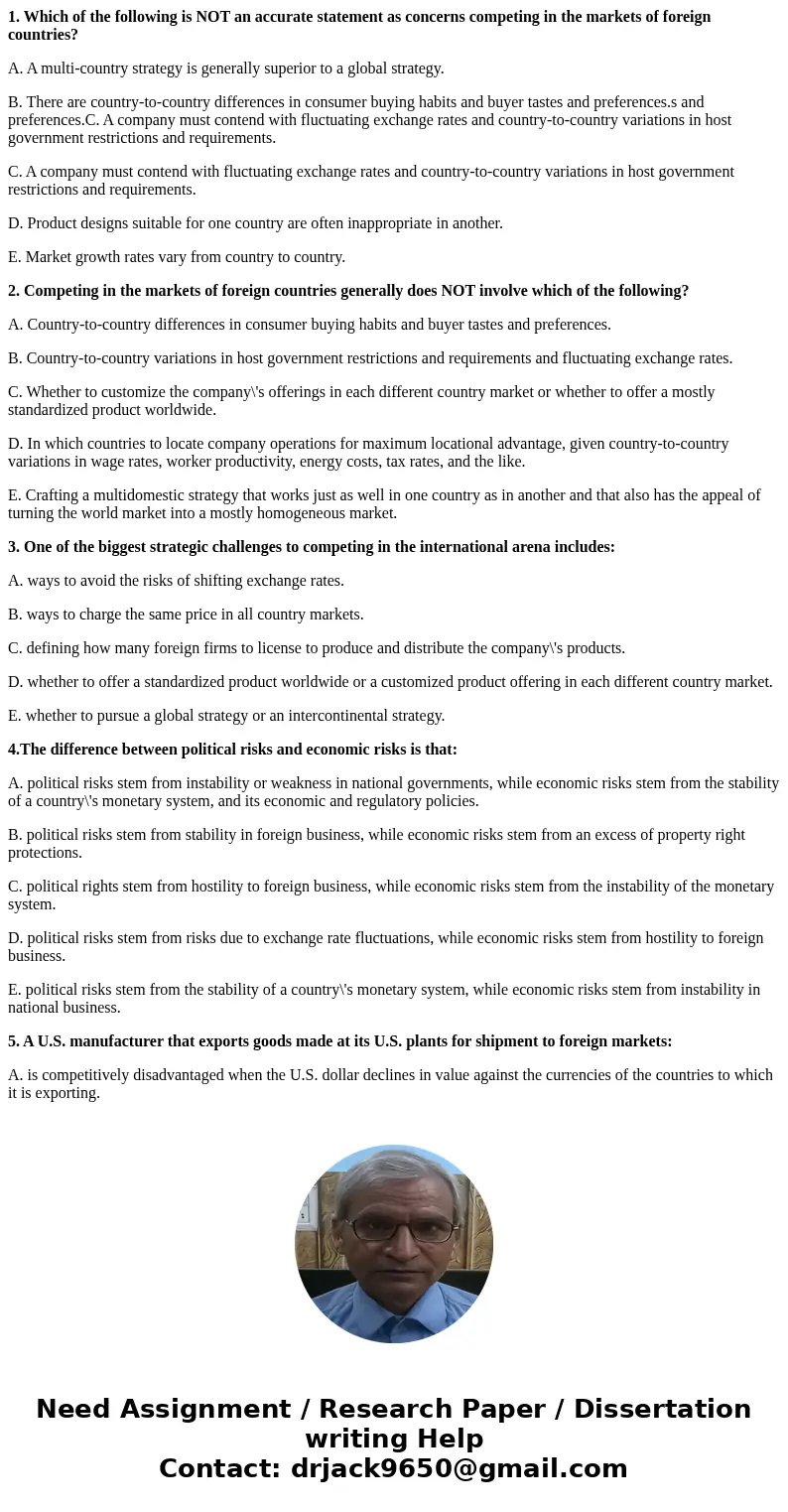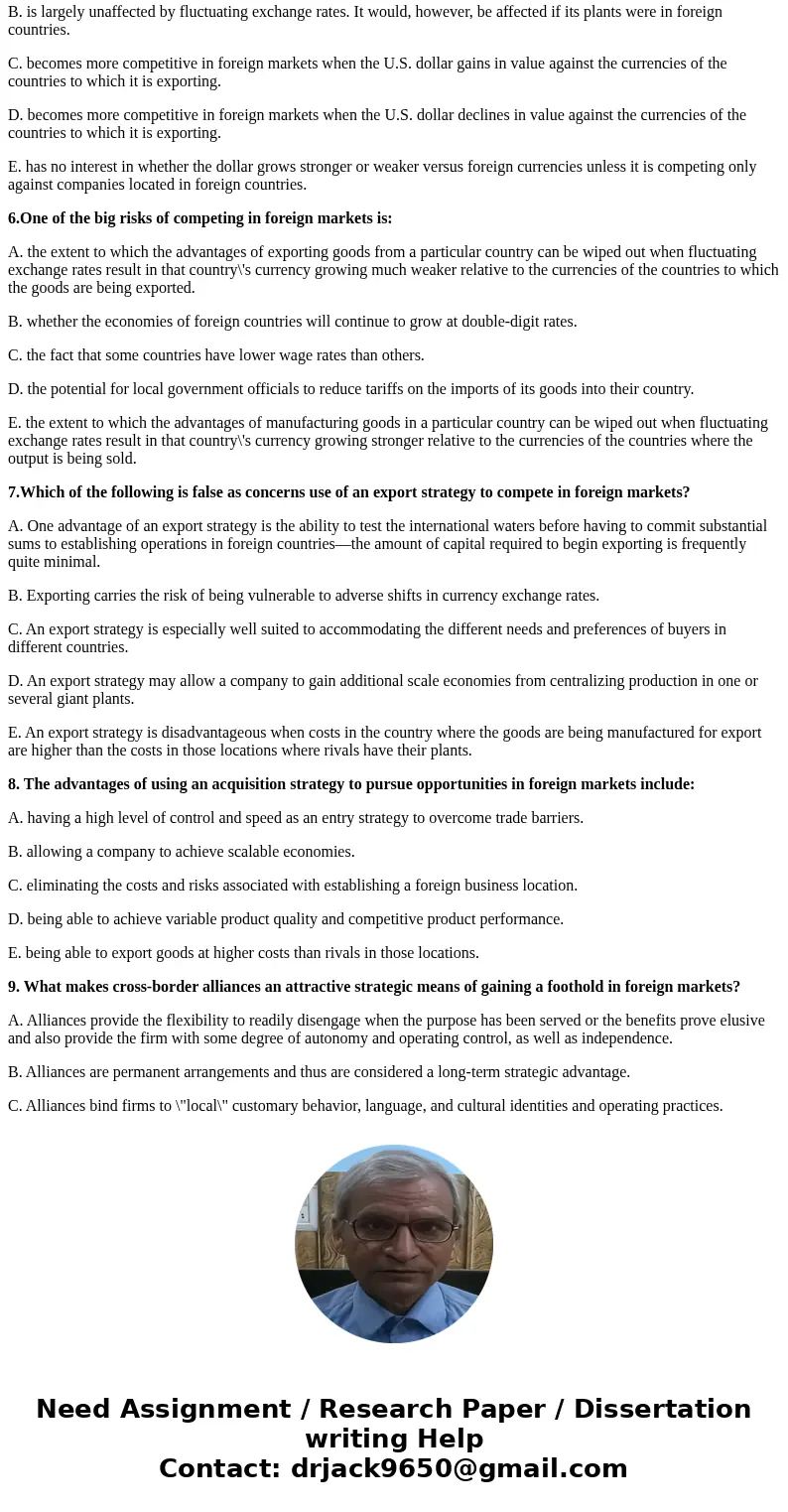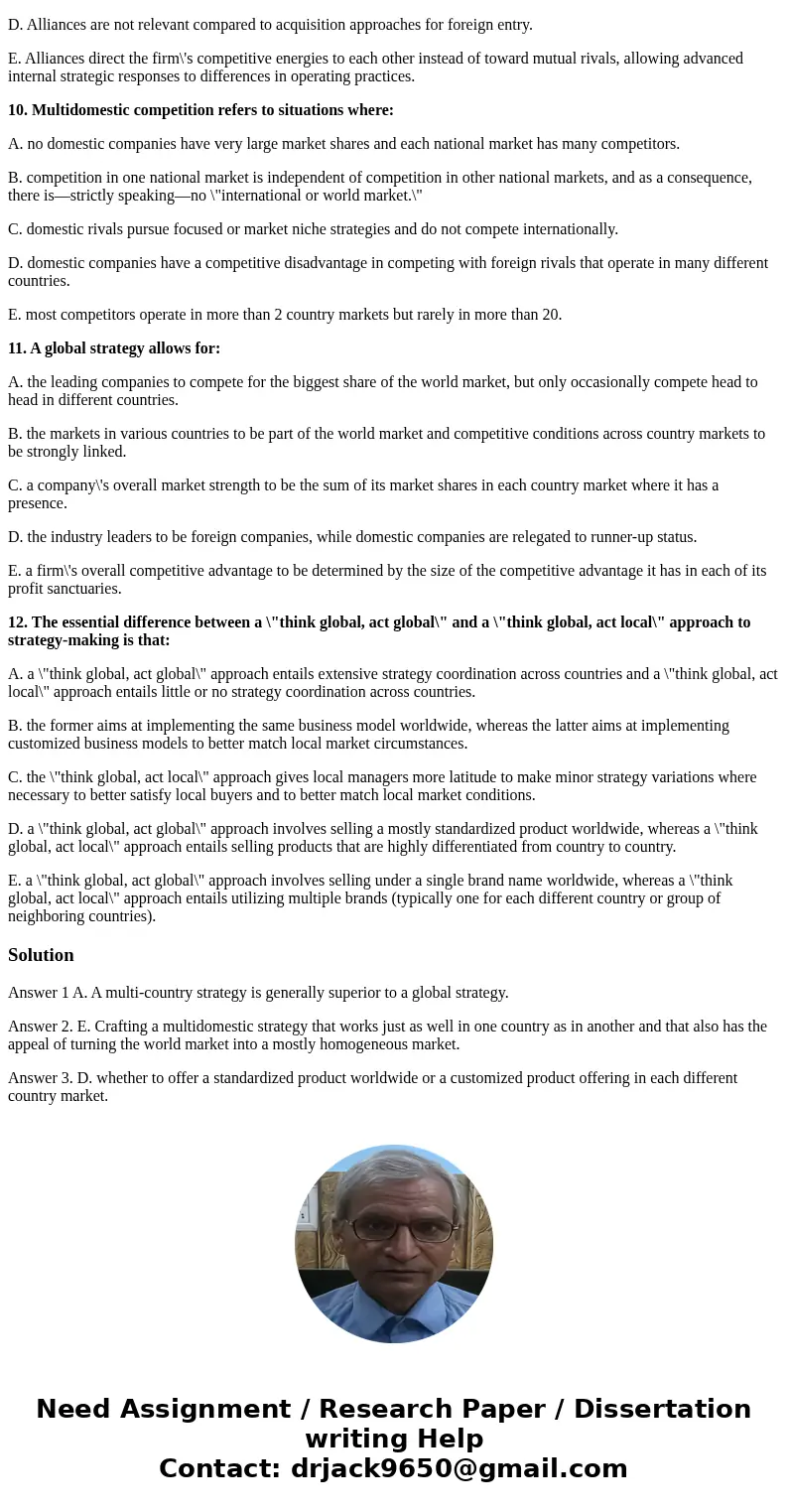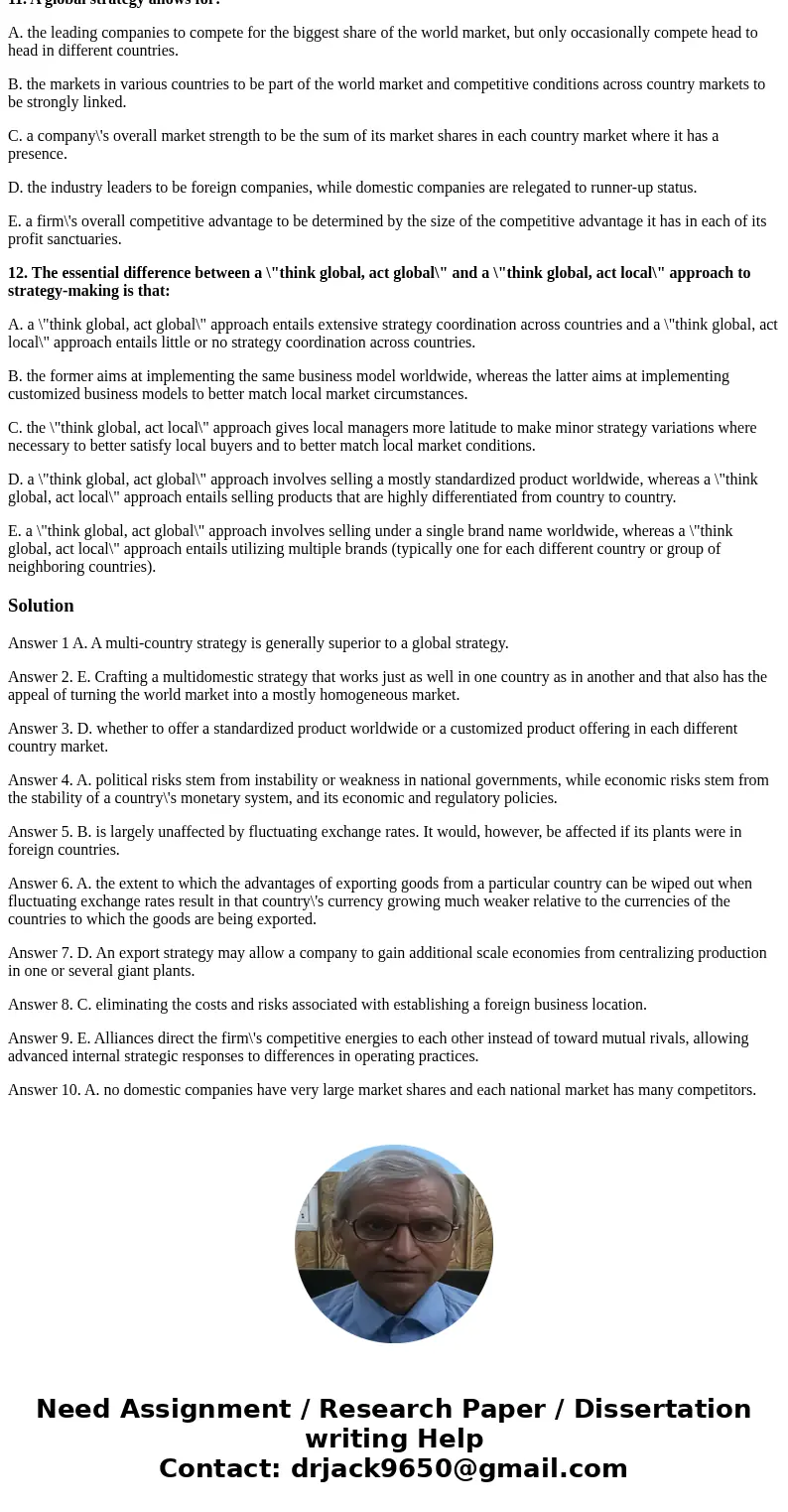1 Which of the following is NOT an accurate statement as con
1. Which of the following is NOT an accurate statement as concerns competing in the markets of foreign countries?
A. A multi-country strategy is generally superior to a global strategy.
B. There are country-to-country differences in consumer buying habits and buyer tastes and preferences.s and preferences.C. A company must contend with fluctuating exchange rates and country-to-country variations in host government restrictions and requirements.
C. A company must contend with fluctuating exchange rates and country-to-country variations in host government restrictions and requirements.
D. Product designs suitable for one country are often inappropriate in another.
E. Market growth rates vary from country to country.
2. Competing in the markets of foreign countries generally does NOT involve which of the following?
A. Country-to-country differences in consumer buying habits and buyer tastes and preferences.
B. Country-to-country variations in host government restrictions and requirements and fluctuating exchange rates.
C. Whether to customize the company\'s offerings in each different country market or whether to offer a mostly standardized product worldwide.
D. In which countries to locate company operations for maximum locational advantage, given country-to-country variations in wage rates, worker productivity, energy costs, tax rates, and the like.
E. Crafting a multidomestic strategy that works just as well in one country as in another and that also has the appeal of turning the world market into a mostly homogeneous market.
3. One of the biggest strategic challenges to competing in the international arena includes:
A. ways to avoid the risks of shifting exchange rates.
B. ways to charge the same price in all country markets.
C. defining how many foreign firms to license to produce and distribute the company\'s products.
D. whether to offer a standardized product worldwide or a customized product offering in each different country market.
E. whether to pursue a global strategy or an intercontinental strategy.
4.The difference between political risks and economic risks is that:
A. political risks stem from instability or weakness in national governments, while economic risks stem from the stability of a country\'s monetary system, and its economic and regulatory policies.
B. political risks stem from stability in foreign business, while economic risks stem from an excess of property right protections.
C. political rights stem from hostility to foreign business, while economic risks stem from the instability of the monetary system.
D. political risks stem from risks due to exchange rate fluctuations, while economic risks stem from hostility to foreign business.
E. political risks stem from the stability of a country\'s monetary system, while economic risks stem from instability in national business.
5. A U.S. manufacturer that exports goods made at its U.S. plants for shipment to foreign markets:
A. is competitively disadvantaged when the U.S. dollar declines in value against the currencies of the countries to which it is exporting.
B. is largely unaffected by fluctuating exchange rates. It would, however, be affected if its plants were in foreign countries.
C. becomes more competitive in foreign markets when the U.S. dollar gains in value against the currencies of the countries to which it is exporting.
D. becomes more competitive in foreign markets when the U.S. dollar declines in value against the currencies of the countries to which it is exporting.
E. has no interest in whether the dollar grows stronger or weaker versus foreign currencies unless it is competing only against companies located in foreign countries.
6.One of the big risks of competing in foreign markets is:
A. the extent to which the advantages of exporting goods from a particular country can be wiped out when fluctuating exchange rates result in that country\'s currency growing much weaker relative to the currencies of the countries to which the goods are being exported.
B. whether the economies of foreign countries will continue to grow at double-digit rates.
C. the fact that some countries have lower wage rates than others.
D. the potential for local government officials to reduce tariffs on the imports of its goods into their country.
E. the extent to which the advantages of manufacturing goods in a particular country can be wiped out when fluctuating exchange rates result in that country\'s currency growing stronger relative to the currencies of the countries where the output is being sold.
7.Which of the following is false as concerns use of an export strategy to compete in foreign markets?
A. One advantage of an export strategy is the ability to test the international waters before having to commit substantial sums to establishing operations in foreign countries—the amount of capital required to begin exporting is frequently quite minimal.
B. Exporting carries the risk of being vulnerable to adverse shifts in currency exchange rates.
C. An export strategy is especially well suited to accommodating the different needs and preferences of buyers in different countries.
D. An export strategy may allow a company to gain additional scale economies from centralizing production in one or several giant plants.
E. An export strategy is disadvantageous when costs in the country where the goods are being manufactured for export are higher than the costs in those locations where rivals have their plants.
8. The advantages of using an acquisition strategy to pursue opportunities in foreign markets include:
A. having a high level of control and speed as an entry strategy to overcome trade barriers.
B. allowing a company to achieve scalable economies.
C. eliminating the costs and risks associated with establishing a foreign business location.
D. being able to achieve variable product quality and competitive product performance.
E. being able to export goods at higher costs than rivals in those locations.
9. What makes cross-border alliances an attractive strategic means of gaining a foothold in foreign markets?
A. Alliances provide the flexibility to readily disengage when the purpose has been served or the benefits prove elusive and also provide the firm with some degree of autonomy and operating control, as well as independence.
B. Alliances are permanent arrangements and thus are considered a long-term strategic advantage.
C. Alliances bind firms to \"local\" customary behavior, language, and cultural identities and operating practices.
D. Alliances are not relevant compared to acquisition approaches for foreign entry.
E. Alliances direct the firm\'s competitive energies to each other instead of toward mutual rivals, allowing advanced internal strategic responses to differences in operating practices.
10. Multidomestic competition refers to situations where:
A. no domestic companies have very large market shares and each national market has many competitors.
B. competition in one national market is independent of competition in other national markets, and as a consequence, there is—strictly speaking—no \"international or world market.\"
C. domestic rivals pursue focused or market niche strategies and do not compete internationally.
D. domestic companies have a competitive disadvantage in competing with foreign rivals that operate in many different countries.
E. most competitors operate in more than 2 country markets but rarely in more than 20.
11. A global strategy allows for:
A. the leading companies to compete for the biggest share of the world market, but only occasionally compete head to head in different countries.
B. the markets in various countries to be part of the world market and competitive conditions across country markets to be strongly linked.
C. a company\'s overall market strength to be the sum of its market shares in each country market where it has a presence.
D. the industry leaders to be foreign companies, while domestic companies are relegated to runner-up status.
E. a firm\'s overall competitive advantage to be determined by the size of the competitive advantage it has in each of its profit sanctuaries.
12. The essential difference between a \"think global, act global\" and a \"think global, act local\" approach to strategy-making is that:
A. a \"think global, act global\" approach entails extensive strategy coordination across countries and a \"think global, act local\" approach entails little or no strategy coordination across countries.
B. the former aims at implementing the same business model worldwide, whereas the latter aims at implementing customized business models to better match local market circumstances.
C. the \"think global, act local\" approach gives local managers more latitude to make minor strategy variations where necessary to better satisfy local buyers and to better match local market conditions.
D. a \"think global, act global\" approach involves selling a mostly standardized product worldwide, whereas a \"think global, act local\" approach entails selling products that are highly differentiated from country to country.
E. a \"think global, act global\" approach involves selling under a single brand name worldwide, whereas a \"think global, act local\" approach entails utilizing multiple brands (typically one for each different country or group of neighboring countries).
Solution
Answer 1 A. A multi-country strategy is generally superior to a global strategy.
Answer 2. E. Crafting a multidomestic strategy that works just as well in one country as in another and that also has the appeal of turning the world market into a mostly homogeneous market.
Answer 3. D. whether to offer a standardized product worldwide or a customized product offering in each different country market.
Answer 4. A. political risks stem from instability or weakness in national governments, while economic risks stem from the stability of a country\'s monetary system, and its economic and regulatory policies.
Answer 5. B. is largely unaffected by fluctuating exchange rates. It would, however, be affected if its plants were in foreign countries.
Answer 6. A. the extent to which the advantages of exporting goods from a particular country can be wiped out when fluctuating exchange rates result in that country\'s currency growing much weaker relative to the currencies of the countries to which the goods are being exported.
Answer 7. D. An export strategy may allow a company to gain additional scale economies from centralizing production in one or several giant plants.
Answer 8. C. eliminating the costs and risks associated with establishing a foreign business location.
Answer 9. E. Alliances direct the firm\'s competitive energies to each other instead of toward mutual rivals, allowing advanced internal strategic responses to differences in operating practices.
Answer 10. A. no domestic companies have very large market shares and each national market has many competitors.




 Homework Sourse
Homework Sourse